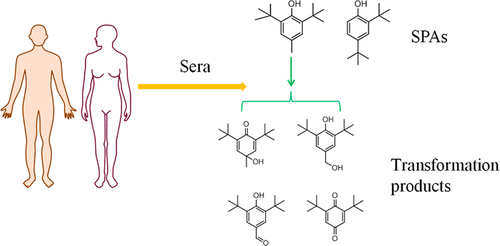当前位置:
X-MOL 学术
›
Environ. Sci. Technol. Lett.
›
论文详情
Our official English website, www.x-mol.net, welcomes your feedback! (Note: you will need to create a separate account there.)
Synthetic Phenolic Antioxidants and Transformation Products in Human Sera from United States Donors
Environmental Science & Technology Letters ( IF 10.9 ) Pub Date : 2018-05-03 , DOI: 10.1021/acs.estlett.8b00223 Runzeng Liu 1 , Scott A. Mabury 1
Environmental Science & Technology Letters ( IF 10.9 ) Pub Date : 2018-05-03 , DOI: 10.1021/acs.estlett.8b00223 Runzeng Liu 1 , Scott A. Mabury 1
Affiliation

|
Synthetic phenolic antioxidants (SPAs) make up a group of widely used anthropogenic additives, whose potential for toxicity has received more attention in recent years. Although SPAs can reach humans through many exposure pathways, few data on the concentrations of SPAs in humans are available. In this study, five SPAs were quantified, at significant concentrations, in 50 individual serum samples collected from donors in the United States. The measured total SPA concentrations [0.46–34.7 ng/mL, geometric mean (GM) of 7.77 ng/mL] were dominated by 2,6-di-tert-butyl-4-methylphenol (BHT) and 2,4-di-tert-butylphenol (DBP), which contributed 42 and 57% on average to the total concentrations, respectively. Four putative biotransformation products (TPs) of BHT [2,6-di-tert-butyl-4-(hydroxymethyl)phenol (BHT-OH), 3,5-di-tert-butyl-4-hydroxybenzaldehyde (BHT-CHO), 2,6-di-tert-butyl-1,4-benzoquinone (BHT-Q), and 2,6-di-tert-butyl-4-hydroxy-4-methyl-2,5-cyclohexadienone (BHT-quinol)] were also detected, with total concentrations ranging from below the method quantification limits to 3.66 ng/mL (GM of 0.77 ng/mL). Five pooled serum samples, each containing sera from at least 1000 donors, were also included in this study. The concentrations of the SPAs (GM of 24.5 ng/mL) and TPs (GM of 10.4 ng/mL) were even higher in pooled sera than in individual samples, indicating the prevalent human burdens of SPAs in a large population. To the best of our knowledge, this is the first analysis of a wide range of SPAs and TPs in human sera.
中文翻译:

美国捐赠者血清中的合成酚类抗氧化剂和转化产物
合成酚类抗氧化剂(SPA)构成了一组广泛使用的人为添加剂,其毒性潜力近年来受到了越来越多的关注。尽管SPA可以通过许多暴露途径到达人体,但是关于SPA在人体中的浓度的数据很少。在这项研究中,从美国供体中收集的50个单独的血清样品中,以非常高的浓度对5个SPA进行了定量。测得的总SPA浓度[0.46–34.7 ng / mL,几何平均值(GM)为7.77 ng / mL]主要由2,6-二叔丁基-4-甲基苯酚(BHT)和2,4-二-叔丁基苯酚(DBP),分别平均占总浓度的42%和57%。BHT的四种推定的生物转化产物(TP)[2,6-二酯丁基-4-(羟甲基)苯酚(BHT-OH),3,5-二叔丁基-4-羟基苯甲醛(BHT-CHO),2,6-二叔丁基-1,4-苯醌(还检测到了BHT-Q)和2,6-二叔丁基-4-羟基-4-甲基-2,5-环己二酮(BHT-喹诺酮),总浓度在方法定量限值以下至3.66 ng / mL(GM为0.77 ng / mL)。这项研究还包括5个合并的血清样本,每个样本都包含至少1000个供体的血清。合并血清中的SPAs(GM为24.5 ng / mL的GM)和TPs(GM为10.4 ng / mL的)的浓度甚至高于单个样品,这表明SPA在大量人群中是人类的主要负担。据我们所知,这是对人类血清中多种SPA和TP的首次分析。
更新日期:2018-05-04
中文翻译:

美国捐赠者血清中的合成酚类抗氧化剂和转化产物
合成酚类抗氧化剂(SPA)构成了一组广泛使用的人为添加剂,其毒性潜力近年来受到了越来越多的关注。尽管SPA可以通过许多暴露途径到达人体,但是关于SPA在人体中的浓度的数据很少。在这项研究中,从美国供体中收集的50个单独的血清样品中,以非常高的浓度对5个SPA进行了定量。测得的总SPA浓度[0.46–34.7 ng / mL,几何平均值(GM)为7.77 ng / mL]主要由2,6-二叔丁基-4-甲基苯酚(BHT)和2,4-二-叔丁基苯酚(DBP),分别平均占总浓度的42%和57%。BHT的四种推定的生物转化产物(TP)[2,6-二酯丁基-4-(羟甲基)苯酚(BHT-OH),3,5-二叔丁基-4-羟基苯甲醛(BHT-CHO),2,6-二叔丁基-1,4-苯醌(还检测到了BHT-Q)和2,6-二叔丁基-4-羟基-4-甲基-2,5-环己二酮(BHT-喹诺酮),总浓度在方法定量限值以下至3.66 ng / mL(GM为0.77 ng / mL)。这项研究还包括5个合并的血清样本,每个样本都包含至少1000个供体的血清。合并血清中的SPAs(GM为24.5 ng / mL的GM)和TPs(GM为10.4 ng / mL的)的浓度甚至高于单个样品,这表明SPA在大量人群中是人类的主要负担。据我们所知,这是对人类血清中多种SPA和TP的首次分析。



























 京公网安备 11010802027423号
京公网安备 11010802027423号